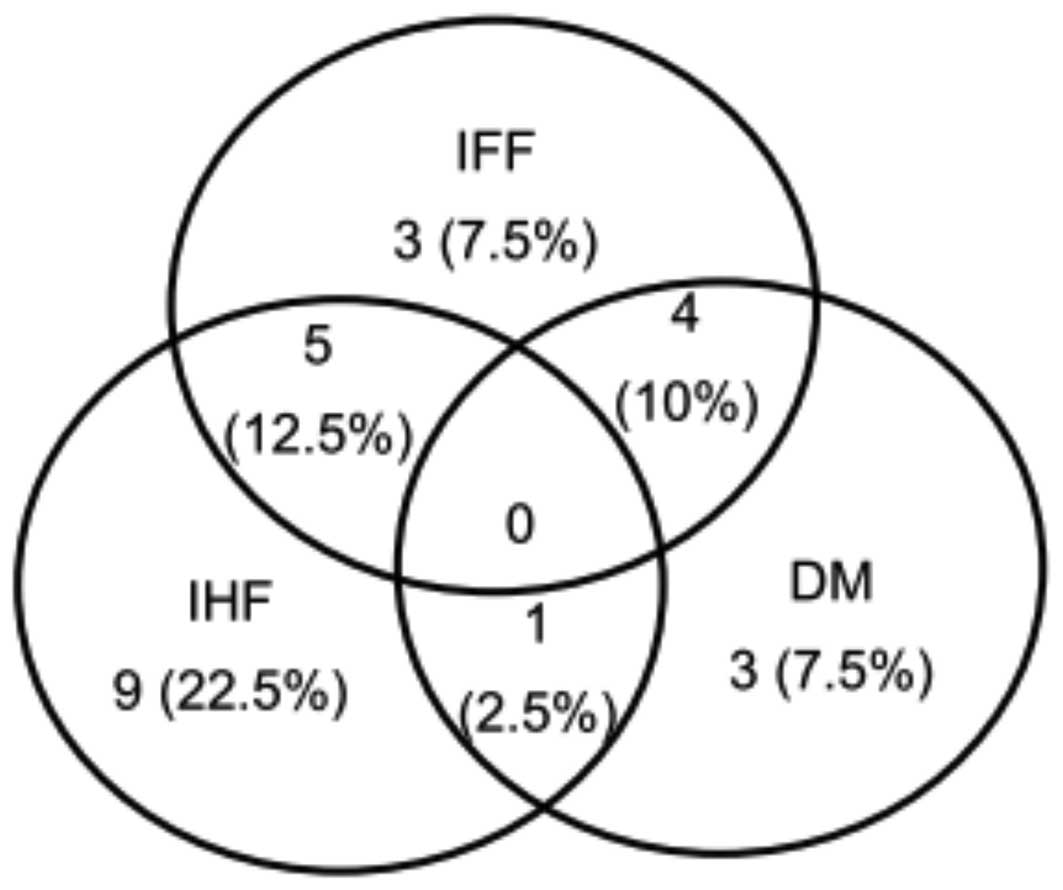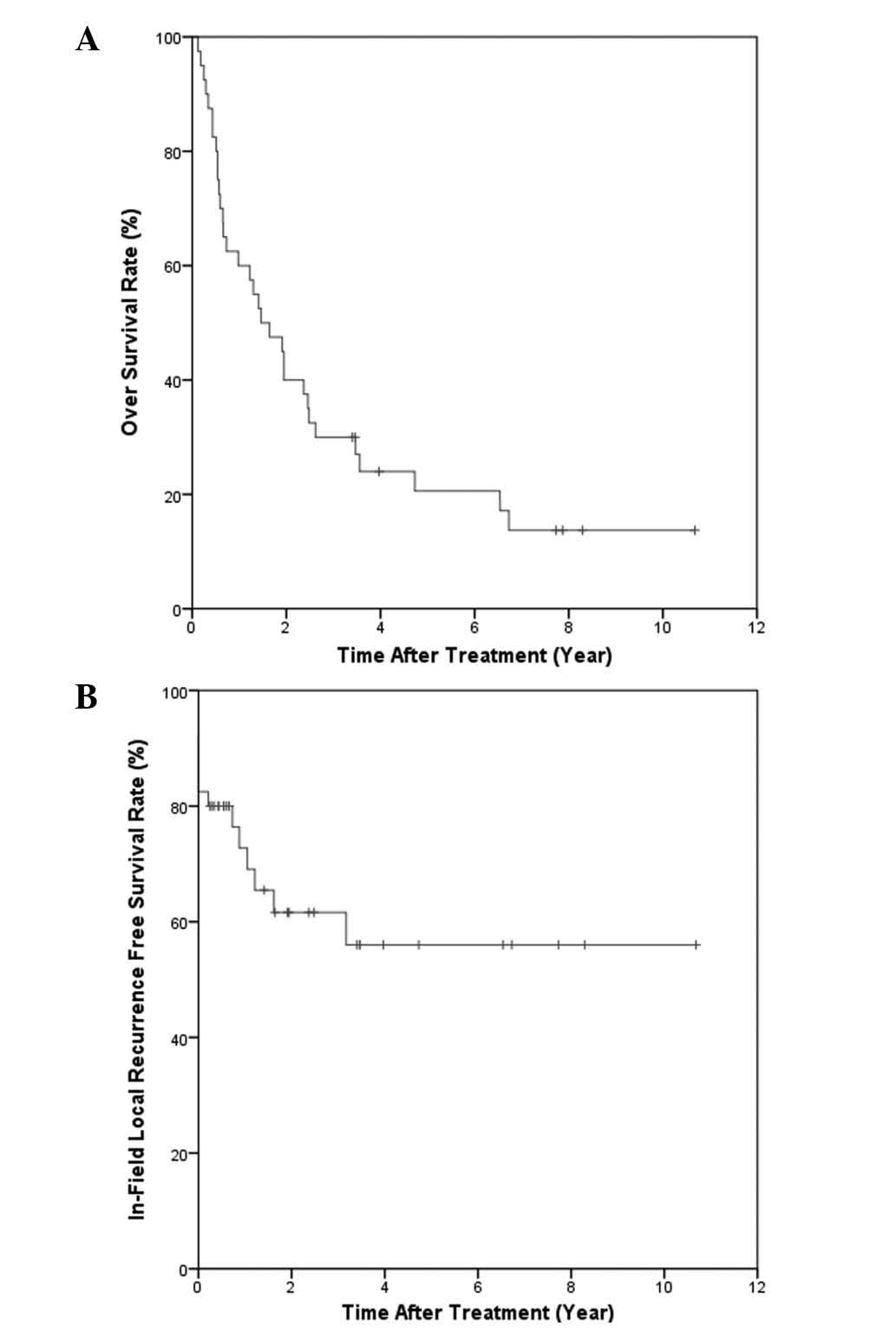|
1
|
Venook AP, Papandreou C, Furuse J and de
Guevara LL: The incidence and epidemiology of hepatocellular
carcinoma: a global and regional perspective. Oncologist. 15(Suppl
4): 5–13. 2010. View Article : Google Scholar : PubMed/NCBI
|
|
2
|
Liu CL and Fan ST: Nonresectional
therapies for hepatocellular carcinoma. Am J Surg. 173:358–365.
1997. View Article : Google Scholar : PubMed/NCBI
|
|
3
|
Ye SL, Takayama T, Geschwind J, Marrero JA
and Bronowicki JP: Current approaches to the treatment of early
hepatocellular carcinoma. Oncologist. 15(Suppl 4): 34–41. 2010.
View Article : Google Scholar : PubMed/NCBI
|
|
4
|
Khan KN, Yatsuhashi H, Yamasaki K, et al:
Prospective analysis of risk factors for early intrahepatic
recurrence of hepatocellular carcinoma following ethanol injection.
J Hepatol. 32:269–278. 2000. View Article : Google Scholar : PubMed/NCBI
|
|
5
|
Lin SM, Lin CJ, Lin CC, Hsu CW and Chen
YC: Randomised controlled trial comparing percutaneous
radiofrequency thermal ablation, percutaneous ethanol injection,
and percutaneous acetic acid injection to treat hepatocellular
carcinoma of 3 cm or less. Gut. 54:1151–1156. 2005. View Article : Google Scholar
|
|
6
|
Llovet JM and Bruix J: Systematic review
of randomized trials for unresectable hepatocellular carcinoma:
Chemoembolization improves survival. Hepatology. 37:429–442. 2003.
View Article : Google Scholar
|
|
7
|
Park W, Lim DH, Paik SW, et al: Local
radiotherapy for patients with unresectable hepatocellular
carcinoma. Int J Radiat Oncol Biol Phys. 61:1143–1150. 2005.
View Article : Google Scholar : PubMed/NCBI
|
|
8
|
Kawashima M, Furuse J, Nishio T, et al:
Phase II study of radiotherapy employing proton beam for
hepatocellular carcinoma. J Clin Oncol. 23:1839–1846. 2005.
View Article : Google Scholar : PubMed/NCBI
|
|
9
|
Tse RV, Hawkins M, Lockwood G, et al:
Phase I study of individualized stereotactic body radiotherapy for
hepatocellular carcinoma and intrahepatic cholangiocarcinoma. J
Clin Oncol. 26:657–664. 2008. View Article : Google Scholar : PubMed/NCBI
|
|
10
|
Toronto UHN. Stereotactic Body Radiation
Therapy (SBRT) Hepatocellular Carcinoma. Journal. Available from:
http://www.clinicaltrials.gov/ct2/show/NCT00914355?term=HCC+SBRT&rank=00914355.
NLM Identifier: NCT00914355. Accessed April 25, 2012
|
|
11
|
Desmet VJ, Gerber M, Hoofnagle JH, Manns M
and Scheuer PJ: Classification of chronic hepatitis: diagnosis,
grading and staging. Hepatology. 19:1513–1520. 1994. View Article : Google Scholar : PubMed/NCBI
|
|
12
|
No authors listed. A new prognostic system
for hepatocellular carcinoma: a retrospective study of 435
patients: the Cancer of the Liver Italian Program (CLIP)
investigators. Hepatology. 28:751–755. 1998. View Article : Google Scholar : PubMed/NCBI
|
|
13
|
Miller AB, Hoogstraten B, Staquet M and
Winkler A: Reporting results of cancer treatment. Cancer.
47:207–214. 1981. View Article : Google Scholar : PubMed/NCBI
|
|
14
|
Pan CC, Kavanagh BD, Dawson LA, et al:
Radiation-associated liver injury. Int J Radiat Oncol Biol Phys.
76:S94–S100. 2010. View Article : Google Scholar : PubMed/NCBI
|
|
15
|
Cheng SH, Lin YM, Chuang VP, et al: A
pilot study of three-dimensional conformal radiotherapy in
unresectable hepatocellular carcinoma. J Gastroenterol Hepatol.
14:1025–1033. 1999. View Article : Google Scholar : PubMed/NCBI
|
|
16
|
Ingold JA, Reed GB, Kaplan HS and Bagshaw
MA: Radiation hepatitis. Am J Roentgenol Radium Ther Nucl Med.
93:200–208. 1965.PubMed/NCBI
|
|
17
|
Russell AH, Clyde C, Wasserman TH, Turner
SS and Rotman M: Accelerated hyperfractionated hepatic irradiation
in the management of patients with liver metastases: results of the
RTOG dose escalating protocol. Int J Radiat Oncol Biol Phys.
27:117–123. 1993. View Article : Google Scholar : PubMed/NCBI
|
|
18
|
Lawrence TS, Dworzanin LM, Walker-Andrews
SC, et al: Treatment of cancers involving the liver and porta
hepatis with external beam irradiation and intraarterial hepatic
fluorodeoxyuridine. Int J Radiat Oncol Biol Phys. 20:555–561. 1991.
View Article : Google Scholar : PubMed/NCBI
|
|
19
|
Lawrence TS, Ten Haken RK, Kessler ML, et
al: The use of 3-D dose volume analysis to predict radiation
hepatitis. Int J Radiat Oncol Biol Phys. 23:781–788.
1992.PubMed/NCBI
|
|
20
|
Dawson LA, McGinn CJ, Normolle D, et al:
Escalated focal liver radiation and concurrent hepatic artery
fluorodeoxyuridine for unresectable intrahepatic malignancies. J
Clin Oncol. 18:2210–2218. 2000.PubMed/NCBI
|
|
21
|
Park HC, Seong J, Han KH, Chon CY, Moon YM
and Suh CO: Dose-response relationship in local radiotherapy for
hepatocellular carcinoma. Int J Radiat Oncol Biol Phys. 54:150–155.
2002. View Article : Google Scholar : PubMed/NCBI
|
|
22
|
Liu MT, Li SH, Chu TC, et al:
Three-dimensional conformal radiation therapy for unresectable
hepatocellular carcinoma patients who had failed with or were
unsuited for transcatheter arterial chemoembolization. Jpn J Clin
Oncol. 34:532–539. 2004. View Article : Google Scholar
|
|
23
|
Seong J, Park HC, Han KH and Chon CY:
Clinical results and prognostic factors in radiotherapy for
unresectable hepatocellular carcinoma: a retrospective study of 158
patients. Int J Radiat Oncol Biol Phys. 55:329–336. 2003.
View Article : Google Scholar : PubMed/NCBI
|
|
24
|
Liang SX, Zhu XD, Lu HJ, et al:
Hypofractionated three-dimensional conformal radiation therapy for
primary liver carcinoma. Cancer. 103:2181–2188. 2005. View Article : Google Scholar : PubMed/NCBI
|
|
25
|
Bae SH, Park HC, Lim do H, et al: Salvage
treatment with hypofractionated radiotherapy in patients with
recurrent small hepatocellularcarcinoma. Int J Radiat Oncol Biol
Phys. 82:e603–e607. 2012. View Article : Google Scholar : PubMed/NCBI
|
|
26
|
Kwon JH, Bae SH, Kim JY, et al: Long-term
effect of stereotactic body radiation therapy for primary
hepatocellular carcinoma ineligible for local ablation therapy or
surgical resection. Stereotactic radiotherapy for liver cancer. BMC
Cancer. 10:4752010. View Article : Google Scholar
|
|
27
|
Dawson LA and Ten Haken RK: Partial volume
tolerance of the liver to radiation. Semin Radiat Oncol.
15:279–283. 2005.PubMed/NCBI
|
|
28
|
Cheng JC, Wu JK, Lee PC, et al: Biologic
susceptibility of hepatocellular carcinoma patients treated with
radiotherapy to radiation-induced liver disease. Int J Radiat Oncol
Biol Phys. 60:1502–1509. 2004. View Article : Google Scholar : PubMed/NCBI
|
|
29
|
Cheng JC, Liu HS, Wu JK, Chung HW and Jan
GJ: Inclusion of biological factors in parallel-architecture
normal-tissue complication probability model for radiation-induced
liver disease. Int J Radiat Oncol Biol Phys. 62:1150–1156. 2005.
View Article : Google Scholar
|
|
30
|
Kim JH, Park JW, Kim TH, Koh DW, Lee WJ
and Kim CM: Hepatitis B virus reactivation after three-dimensional
conformal radiotherapy in patients with hepatitis B virus-related
hepatocellular carcinoma. Int J Radiat Oncol Biol Phys. 69:813–819.
2007. View Article : Google Scholar
|
|
31
|
Chou CH, Chen PJ, Lee PH, Cheng AL, Hsu HC
and Cheng JC: Radiation-induced hepatitis B virus reactivation in
liver mediated by the bystander effect from irradiated endothelial
cells. Clin Cancer Res. 13:851–857. 2007. View Article : Google Scholar : PubMed/NCBI
|
|
32
|
Liang SX, Zhu XD, Xu ZY, et al:
Radiation-induced liver disease in three-dimensional conformal
radiation therapy for primary liver carcinoma: the risk factors and
hepatic radiation tolerance. Int J Radiat Oncol Biol Phys.
65:426–434. 2006. View Article : Google Scholar
|
|
33
|
Xu ZY, Liang SX, Zhu J, et al: Prediction
of radiation-induced liver disease by Lyman normal-tissue
complication probability model in three-dimensional conformal
radiation therapy for primary liver carcinoma. Int J Radiat Oncol
Biol Phys. 65:189–195. 2006. View Article : Google Scholar
|
|
34
|
Levy I and Sherman M; Liver Cancer Study
Group of the University of Toronto. Staging of hepatocellular
carcinoma: assessment of the CLIP, Okuda, and Child-Pugh staging
systems in a cohort of 257 patients in Toronto. Gut. 50:881–885.
2002. View Article : Google Scholar : PubMed/NCBI
|
|
35
|
Ueno S, Tanabe G, Sako K, et al:
Discrimination value of the new western prognostic system (CLIP
score) for hepatocellular carcinoma in 662 Japanese patients.
Cancer of the Liver Italian Program Hepatology. 34:529–534.
2001.PubMed/NCBI
|
|
36
|
Lo CM, Ngan H, Tso WK, et al: Randomized
controlled trial of transarterial lipiodol chemoembolization for
unresectable hepatocellular carcinoma. Hepatology. 35:1164–1171.
2002. View Article : Google Scholar : PubMed/NCBI
|
|
37
|
Llovet JM, Real MI, Montana X, et al:
Barcelona Liver Cancer Group: Arterial embolisation or
chemoembolisation versus symptomatic treatment in patients with
unresectable hepatocellular carcinoma: a randomised controlled
trial. Lancet. 359:1734–1739. 2002. View Article : Google Scholar
|
|
38
|
Lin DY, Liaw YF, Lee TY and Lai CM:
Hepatic arterial embolization in patients with unresectable
hepatocellular carcinoma - a randomized controlled trial.
Gastroenterology. 94:453–456. 1988.PubMed/NCBI
|
















